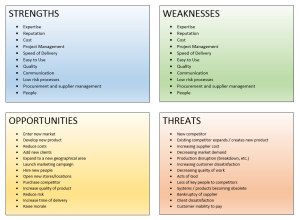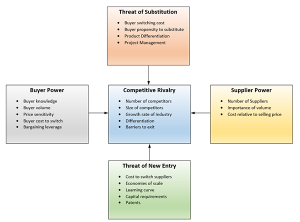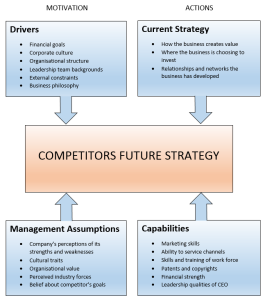
Strategic planning involves the development of actions that support the achievement of a corporate goal. The corporate goals must be defined first, and the strategic plan becomes the “how to” manual to achieve the goals.
Business schools make strategic planning more complicated than it is. If you understand these 8 tools, you’ve mostly mastered the subject:
- PEST analysis
- SWOT analysis
- Value chain analysis
- Five forces analysis
- Four corners analysis
- Key Performance Indicators
- Force Field Analysis
- War gaming
PEST Analysis
This is a nifty little tool that quantifies and analyzes the external factors that affect an organization. The acronym stands for:
- Political factors refers to the regulations that pertain to an organization’s core activities. Also, tax laws, environmental regulations, tariffs, trade restrictions, and political instability can be important considerations.
- Economic factors are the applicable growth rates and their future projections. Market demand for a product and supply from competitors, as well as interest rates, inflation, and currency exchange rates are considered under this category.
- Social factors affecting an organization include population growth, demographics, and changing attitudes toward products and services.
- Technological factors include the forces of technological change that make products obsolete or reduce cost within the manufacturing process.
SWOT Analysis
 Like a SWAT team that hunts down and attacks its criminal prey, a SWOT analysis is a tool used to determine the positioning of an organization within its industry to fight its competitors. The acronym stands for:
Like a SWAT team that hunts down and attacks its criminal prey, a SWOT analysis is a tool used to determine the positioning of an organization within its industry to fight its competitors. The acronym stands for:
- Strengths. What are the organizations strengths? For example, expertise, reputation, cost, project management, speed of delivery, ease of use, quality, communication, low risk processes, procurement and supplier management, and people.
- Weaknesses. For example, expertise, reputation, cost, project management, speed of delivery, ease of use, quality, communication, low risk processes, procurement and supplier management, and people.
- Opportunities. For example, entering a new market, developing a new product, reducing costs, adding new clients, expanding into new geographical areas, launching a marketing campaign, hiring new people, opening new stores/locations, purchasing a competitor, increasing product quality, reducing risk, decreasing delivery time, or raising morale.
- Threats. For example, new competitors, existing competitors expanding, supplier costs increasing, market demand decreasing, production disruptions, customer dissatisfaction, decreasing quality of work, acts of God, loss of key people, systems becoming obsolete, bankruptcy of supplier, client dissatisfaction, or a client’s inability to pay.
Each of these are usually plotted on a 2 x 2 matrix with Strengths at the top left and Threats in the bottom right. Click on the image to see a larger version.
Value Chain Analysis
This method involves an analysis of the value chain to identify improvements. The value chain is defined as the process by which value is consistently increased as a product is further refined. Every business has inputs which they convert to outputs, and for this they charge a fee. Thus, value is created from one step to the next.
Value Chain Analysis involves the following three steps:
- Identification of the value chain. For example, a drilling company drills geotechnical drill holes for a highway. An engineering company tests the core and recommends a type of road material. A gravel pit mines and crushes the material, and a contractor places it. The value of the finished product, the highway, is divided into each of the different pieces which make up the value chain.
- Analyzing the value chain that is attributed to your organization. For a manufacturing company, this is easy. It’s the selling price of the widget minus the cost of its parts (that have been purchased externally). For other types of companies this may be more complicated but it’s really not rocket science. It’s the value of the finished product which is attributed to your organization.
- Evaluating potential improvements to the value chain. Key improvement projects can be identified and initiated to make improvements to the value chain. This usually comes in one of five ways:
- Adding features
- Reducing cost
- Increasing price
- Providing additional support
- Increasing brand value
Five Forces Analysis
 This tool analyzes the attractiveness of a market for the purpose of doing business. The five forces are:
This tool analyzes the attractiveness of a market for the purpose of doing business. The five forces are:
- Supplier Power measures the ability of suppliers to take the competitive advantage away by raising prices.
- Buyer Power measures the ability of buyers to drive prices down.
- Competitive Rivalry measures the number of competitors in the marketplace and their relative strengths.
- Threat of Substitution measures the number of alternative products in the market and how easily they can make your product obsolete.
- Threat of New Entry measures the barriers to entry and number of potential future competitors.
Four Corners Analysis
 This tool focuses on the analysis of competitors in an attempt to glean their potential future strategy. The four corners are:
This tool focuses on the analysis of competitors in an attempt to glean their potential future strategy. The four corners are:
- Drivers involve an organization’s existing situation, such as corporate culture, financial position, organizational structure and bureaucracy.
- Management assumptions are the ideas management have about themselves, the company, and ability to compete in various markets.
- Strategy is the organization’s goals and mission, and where it is investing its profits.
- Capabilities is the technical or marketing ability to enter a market.
Key Performance Indicators
Also called KPI’s, these represent the metrics by which the progress toward a corporate goal is tracked and the goal is defined as a success or failure. If you do nothing else, make sure you have good KPI’s and track them on a weekly basis.
A Key Performance Indicator should be a SMART goal:
- Specific
- Measurable
- Achievable
- Relevant
- Time-bound
Examples of KPI’s are earnings per share, business unit revenue, number of widgets produced, or number of repeat clients. Every business manager should have good KPI’s that are measured and reviewed regularly (weekly is usually a good time frame).
Force Field Analysis
 This very simple tool is used for decision making. It involves itemizing each relevant factor that weighs in on a decision, in a pro and con table format, and assigning relative weights to each. Once added up, each side represents the forces for and against change.
This very simple tool is used for decision making. It involves itemizing each relevant factor that weighs in on a decision, in a pro and con table format, and assigning relative weights to each. Once added up, each side represents the forces for and against change.
War Gaming
This tool involves an attempt to replicate a strategic move in a no risk environment. Usually a retreat is planned for several of an organization’s members. Teams are formed which represent the company and its major competitors. Starting with the home team, who starts by making the move being tested, each team analyzes its position and submits its response. It’s an unconventional exercise, but results in fantastic knowledge of an organization relative to its competitors.
Do you have any other tools in your strategic planning toolbox? Tell us in the comments how they worked and what the results were.






